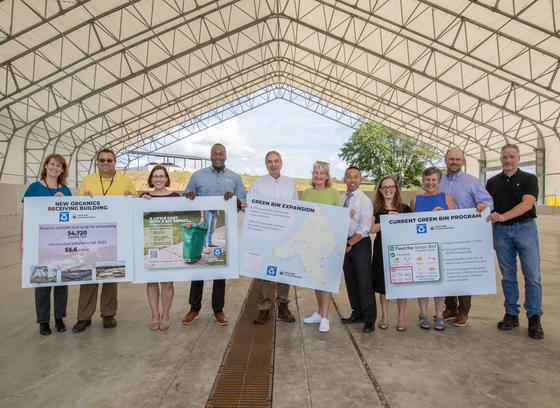About
Solid waste management activities in Howard County are carried out by the Bureau of Environmental Services. Its mission to advance environmental responsibility and provide a more sustainable waste management program is measured through the framework of:
- Collection of residential solid waste and recyclable materials
- Recovery and diversion of recyclable materials
- Disposal of remaining waste materials
The current solid waste plan, reports and studies are updated and reviewed by the Bureau and made available to residents and businesses in Howard County.

Solid Waste Management Plan
Current Plan (2025-2034)
Solid waste management activities in Howard County are carried out by the Bureau of Environmental Services. In accordance with the Maryland Code of Regulations (COMAR 26.03.03) Howard County establishes a plan for sustainable management of solid waste every ten years.
Facts & Statistics
What is Howard County's waste diversion rate?
In 2023, Howard County's waste diversion rate was 50.99%. The waste diversion goal is comprised of the recycling rate plus source reduction credits* (maximum 5%) that Maryland Counties and Baltimore City earn through activities designed to reduce the amount of waste going to the waste stream.
*Each county is required to report to Maryland Department of the Environment (MDE) on activities designed to reduce the amount of material that is landfilled other than through recycling. These 'Source Reduction Activities' can include advertising efforts such as those designed to promote composting or grasscycling, promoting food donation, coordinating textile reuse programs, pallet reuse program, etc. Each county is eligible to receive up to a 5% credit. Howard County has received the full 5% credit almost every year for the past 25 years.
What is the residential participation rate for curbside recycling?
We frequently conduct field audits in each Trash & Recycling Zone (TRZ) to determine residential participation in our curbside recycling program. A summary of our current participation rates can be found below.
How much is recycled in Howard County?
In 2024, Howard County managed a total of 186,945 tons of MSW (municipal solid waste). Of that, 50,187 tons were recycled or reused and 8,831 tons of organic material from curbside collections
What's in my blue recycling cart?
Paper and Cardboard – 58%
Glass Bottles – 16%
Aluminum Cans – 1.8%
Water & Soda Bottles – 4.9%
Metal Cans – 1.3%
Milk Containers - 1%
Liquid Detergent Containers – 1.6%
Other Plastic Containers (#3-7) – 3%
Rigid Plastics - 1.2%
Trash – 10.5%
Percentages based on average weights from recent audits. Trash includes items that are not recyclable, as well as items that do not belong in the blue cart but can be recycled in our other programs (textiles, yard trim, scrap metal, etc.). These items placed in the blue recycling carts are sorted out as trash and will not be recycled. Help us achieve a cleaner stream by reviewing our curbside collection rules and regulations.
How much is being composted in Howard County?
In 2024, the Composting Facility at Alpha Ridge Landfill produced 17,347 tons of compost. HoCoGro Compost is made from food scraps and yard trim from the Feed the Green Bin program and manure/barn cleanings.
What's in our trash in Howard County?
Every few years the Bureau conducts a Waste Characterization Study to determine the makeup of the County's residential solid waste. A random sample of material from each Trash & Recycling Zone (TRZ) was manually sorted into 52 material categories. Some key findings from the study were:
- Organics (food scraps, yard trim and compostable products) comprise an estimated 38.3% of the residential waste stream
- Paper and cardboard make up the second largest category at 20.9%
- 32.2% of the waste stream was material that is not currently recoverable (through curbside collection and drop-off recycling at Alpha Ridge Landfill)
The findings suggest that expanding and promoting recycling and food scrap diversion is needed to further reduce these numbers.
What's going on at the Alpha Ridge Landfill?
In 2024, we gave away about 600 compost bins!
We collected:
- an average of 50 flags per month for retirement.
- 2,830 bikes were donated (over 10,800 since the program began in 2016)
- 1,627 mattresses and/or box springs
- 54.08 tons of car batteries
- 168.96 tons of tires
- 295.49 tons of single stream
- 245.13 tons of rigid plastics
- 407.03 tons of cardboard
- 13.59 tons of cooking oil
- 56.90 tons of textiles
- 39.34 tons of books